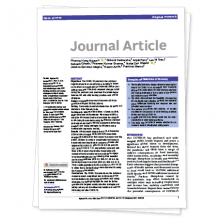Journal article
Jan 25 2017

Changes in underlying determinants explain rapid increases in child linear growth in Alive & Thrive study areas between 2010 and 2014 in Bangladesh and Viet Nam (Nguyen PH., 2016. Journal of Nutrition)
This study aimed to better understand what changes in underlying socioeconomic characteristics and behavioral factors are important in explaining improvements in child linear growth in A&T study areas in Bangladesh and Viet Nam.
Journal article
Dec 28 2016

Large-scale behavior-change initiative for infant and young child feeding advanced language and motor development in a cluster-randomized program evaluation in Bangladesh (Frongillo EA., 2017. Journal of Nutrition)
Improving infant and young child feeding (IYCF) has the potential to contribute to child development outcomes as well as nutrition.
Journal article
Oct 25 2016

Impacts on breastfeeding practices of at-scale strategies that combine intensive interpersonal counseling, mass media, and community mobilization: results of cluster-randomized program evaluations in Bangladesh and Viet Nam (Menon P., 2016. PLOS Med)
In Bangladesh and Viet Nam between 2009–2014, Alive & Thrive (A&T) worked to improve breastfeeding practices through intensified interpersonal counseling (IPC), mass media (MM), and community mobilization (CM) intervention components delivered at scale in the context of policy advocacy (P
Journal article
Jul 07 2015

Scaling up impact on nutrition: What will it take?
This paper included a literature review and four case studies (including A&T work in Bangladesh) on large-scale nutrition programs with proven impact.
Journal article
Jan 14 2014

Anaemia in infancy in rural Bangladesh: contribution of iron deficiency, infections and poor feeding practices (Rawat, R., 2013. British Journal of Nutrition)
Few data exist on the aetiology of anaemia and Fe deficiency (ID) during early infancy in South Asia. This study aimed to determine the contribution of ID, infections, and feeding practices to anaemia in Bangladeshi infants aged 6-11 months.
Journal article
Dec 13 2013

Handwashing before food preparation and child feeding: a missed opportunity for hygiene promotion (Nizame FA., 2013. American Journal of Tropical Medicine and Hygiene)
Enteric diseases are often caused by poor hygiene and can contribute to stunting. In Bangladesh preparing food, serving food, feeding children, and eating food with bare hands is a common practice, yet most handwashing promotion has focused on fecal contact.

